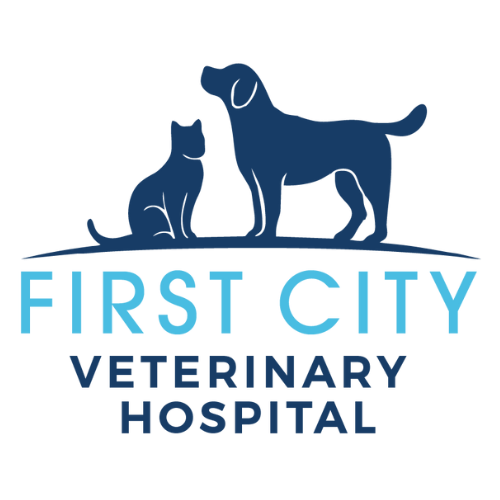At First City Veterinary Hospital we know that dental health is very important to the overall health of our patients. Not only do animals with healthy mouths feel better but they have significantly less heart and kidney disease. Good dental hygiene is just as important for pets as it is for people! Since we feel this is so important, we have made every effort to make dental care affordable.
Did you know that 75%-85% of pets have periodontal disease by the time they are 3 years old?!
Hard to believe, huh? It seems like they were just babies with their sharp pearly whites chewing on every little thing and then, next thing you know, they’ve got periodontal disease!
What is periodontal disease and just how does it happen?
What are signs of periodontal disease?
- Bad Breath- this is one of the first signs that something’s not right
- Red, swollen, or bleeding gums
- Loose or missing teeth or teeth covered in tartar
- Loss of appetite or weight loss
- Drooling, dropping food, difficulty eating
- Pain when eating or when the mouth is touched
So what to do?
Just as with your own teeth, regular brushing at home is the best. Some pets will resist but many will eventually accept it. And for those pets who insist that they NOT have their teeth brushed, there are other products that can help such as dental rinses, dental wipes, or even water additives. Doing a little something is much better than doing a lot of nothing!
If your pet has any of the signs above or if you’re not sure and you would just like a professional opinion, give us a call or stop in!
What is involved with a dental procedure?
What’s involved in a dental cleaning?
Safety is our number one concern so when admitting a patient, a technician will ask a series of important questions (medical issues, current medications, previous history with anesthesia, etc.), then get a phone number so we can contact you with an update after the cleaning is complete.
After the patient is admitted, some blood is drawn for a Pre-anesthetic Blood Profile that we can run on our in-house blood machine to evaluate the functioning of the major organs and gives us a more accurate picture of your pet’s health prior to anesthesia. The more we know, the safer the procedure.
If all is well, the pre-anesthetic is given. This helps the patient relax, relieving them of any anxiety they might experience. The pre-anesthetic also includes some pain medication along with something to stabilize the heart rate. If we know extractions will be necessary, we will also give an injection of an anti-inflammatory medication.
Once the pre-anesthetic has taken effect, an IV catheter is placed. This gives us a port for anesthetic induction and also fluid therapy. Fluids are given throughout the procedure to help stabilize blood pressure. This makes things safer.
The patient is placed on a Hot Dog Warming Blanket and covered with blankets. This helps maintain body temperature which helps metabolize the anesthesia better, which makes things safer.
S/he is then induced with injectable anesthetic so an endotracheal tube (breathing tube) can be placed. The tube is then attached to our anesthetic machine which delivers a precise mixture of oxygen and gas (Isoflurane) to provide anesthetic throughout the procedure.
We then attach the Cardell monitor. This machine monitors the heart rate, blood pressure, EKG, and the amount of oxygen present in the blood. This machine helps us determine when we should make any adjustments to the amount of anesthesia, oxygen, or IV fluids. And this, or course, makes things safer.
An oral exam is performed by the veterinarian and digital radiographs are taken of the entire mouth in order to identify any issues or necessary extractions.
A technician then ultrasonically scales all surfaces of the teeth. Then, using a hand scaler, any tartar below the gum line is removed.
If extractions are necessary, the doctor will perform these procedures. These sites are then lasered to help reduce pain, promote healing, and decrease inflammation.
The technician then polishes all surfaces of the teeth with a dental paste. This helps prevent subsequent tartar buildup. The mouth is then flushed with an antiseptic rinse.
The patient is then recovered in a warm, comfortable, quiet environment to help facilitate a smooth relaxing recovery.
If requested, we will send you a photo of your pet as they recover.
Once the patient is able to stand and walk on their own, they are able to be discharged from the hospital and go home!
Ready to come see us?
Book an appointment with our online system.
Get in touch.
We proudly serve the pets of Oregon City and beyond. Don’t hesitate to contact us today with any questions big or small.

Where to find us.

When we're open.
Sat: 9:00 am – 5:00 pm
Sun: Closed

How to contact us.
Leave us a message.
Have questions? Complete the form below and a member of our team will get back to you as quickly as possible. If you are in need of immediate assistance, please call us directly at 503-657-6553.
